Seize The Book

Jew in the Christian world
Family education with Candace R. Kwiatek, The Dayton Jewish Observer
Jewish groups regularly meet to explore the Torah through traditional commentaries, archaeological and sociological information, historical writings, and modern interpretations.
Unfamiliar with this methodology, many Christians express interest in biblical study accompanied by diverse — even contradictory — commentaries. On the other hand, distinctly conservative adherents to Christianity view all non-literal biblical interpretation as extremely problematic, while the most Orthodox Jews wouldn’t dream of studying the Torah without multiple commentaries at hand.
What Jewish and Christian principles are highlighted by their traditions’ attitudes toward the Bible and biblical commentary?
The Tanakh or Hebrew Bible is the Jewish canon of 24 books divided into three parts: Torah, Prophets, and Writings.
However, Jews also use the word Bible to mean the totality of Written Law (Torah Shebichtav or Tanakh) and Oral Law (Torah Sheba’al Peh, the complete body of teachings including rabbinic and scholarly commentary).
The use of the word Torah (teaching, instruction) is equally multifaceted.
At its most specific, it refers to the Five Books of Moses, but it too can mean all of Written and Oral Law. The broadly inclusive meanings of Bible and Torah highlight a central Jewish tenet: the inextricable link between the biblical narrative and ongoing commentary.
Surprisingly, even the origin of the Torah itself is subject to debate in Jewish commentaries. Traditionalists from as early as Ezra assert that, “the whole Torah (and to a certain extent, the subsequent biblical books and even the rabbinic tradition) is divine,” writes Rabbi David Wolpe in the essay, Did God Write the Bible?
On the other hand, more than a thousand years before classical studies and the Enlightenment introduced a scientific approach to literary analysis, Talmudic and medieval Jewish commentators were pointing out anomalies in the biblical text that are surprisingly modern: repetitions, anachronisms, and historical inconsistencies.

Their contrarian views, too, were duly recorded, debated, and sometimes even endorsed alongside those of the traditionalists.
As so eloquently put in the essay What Congregations Need to Know About the Adult Learner by Isa Aron and Diane T. Schuster, Judaism asserts that the Bible “comes alive when thinking individuals bounce ideas off one another, when everyone’s opinion counts and multiple perspectives are offered.”
Biblical interpretation is not a free-for-all, however. The Oral Law established principles for unpacking the text, and later rabbinic Judaism incorporated them into four broad approaches known by the acronym PaRDeS: pshat (literal), remez (implied); derash (homiletic), and sod (mystical).
Medieval Hellenic and Arabic influences introduced comparative linguistics and philosophy to text analysis, and Kabalah added a mystical dimension, each domain with its own set of rules.
It’s no surprise that modern scientific, historical, and literary analysis have also become part of the Jewish quest to understand the wisdom revealed in the Bible.
Although there is no single Christian biblical canon, the three primary Christian Bibles today — Protestant, Catholic, and Eastern/Greek Orthodox — include the Hebrew Bible (Old Testament) and the 27 books of the New Testament, so named to reflect the Christian worldview.
Distinctive to the Old Testament is its rearrangement of the Hebrew Bible — Pentateuch (Torah), Historical Books, Poetic and Wisdom Books, Prophetic Books — linking the two sets of scriptures by foretelling the arrival of Jesus immediately prior to the record of his life and teachings.
Catholic and Eastern Bibles also expand the Old Testament, adding the Books of Maccabees and Judith among other texts. There may be additional texts, but none of them are commentaries.
While traditional Judaism and Christianity share a conviction in the divine nature of their respective Bibles — “All Scripture is God-breathed (2 Tim. 3:16),” — their conclusions differ.
With its emphasis on correct doctrine or belief, Christianity relies on a single authoritative standard.
In the essay How Do I Interpret the Bible? Robert Verlade, a former editor for Focus on the Family, explains, “…the Bible is always clear when it comes to communicating truths about the essentials of the faith. There are no great secrets, hidden messages or esoteric interpretations that will grant us additional clarity.”
Consequently, some Protestant traditions adhere to sola scriptura, scripture as the supreme authority and arbiter of Christian faith and practice.
Other denominations, including Roman Catholicism, view the Church as divinely appointed to work in tandem with scripture to identify right belief and practice.
Because scripture is viewed as clear, comprehensible, and complete, Christian commentaries generally focus on drawing out the intended meaning of the text rather than expanding upon it (midrash).
Thus, the main methods of Christian exegesis include typology (seeing the New Testament in the Old), historical-grammatical analysis, moral clarification, and thematic development.
These approaches offer new perspectives on scripture without straying from the straightforward meaning of the text.
For Judaism, the Bible and commentary go hand in hand as part of a conversation, an ongoing struggle to understand what God expects.
For Christianity, the Bible alone is the primary source-text for faith. Whether or not divine, the Bible is sacred literature, unequivocally central to both traditions. Carpe Librum: Seize The Book.
Literature to share
Not in God’s Name by Rabbi Jonathan Sacks. From a master teacher and writer comes this highly-acclaimed exploration of the history and consequences of religious violence, particularly focused on the Abrahamic religions of Judaism, Christianity, and Islam. In addition to analyzing how and why religious traditions distort their core values to the point of savagery, Sacks offers some thoughts on how to address today’s religious extremism.
I Say Shehechiyanu by Joanne Rocklin. In simple text and whimsical images, this picture book explores the blessing of thankfulness for new or special experiences. Following the seasons of the year through a preschooler’s eyes, surprisingly simple and unexpected opportunities for gratitude become apparent. A description of the blessing together with the English meaning and Hebrew transliteration make this book universally accessible. A must-have.
To read the complete April 2016 Dayton Jewish Observer, click here.



